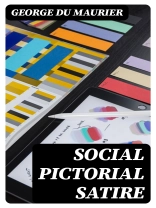In ‘Social Pictorial Satire’ by George Du Maurier, the reader is presented with a collection of insightful and thought-provoking illustrations that critique various aspects of society in the late 19th century. Du Maurier’s subtle yet impactful imagery is a reflection of the Victorian era’s obsession with appearance and social status. His sketches cleverly comment on the class divide, gender roles, and moral values of the time, making this book an important contribution to the tradition of satirical literature. The book’s combination of visual and literary elements provides a unique and engaging reading experience, inviting the reader to analyze and interpret the hidden messages within each illustration. Du Maurier’s wit and artistic talent shine through in every page, offering a glimpse into the social complexities of his time. George Du Maurier’s background as a successful illustrator and writer for publications such as ‘Punch’ magazine undoubtedly influenced his decision to create ‘Social Pictorial Satire’. With its incisive commentary and visual appeal, this book is a must-read for anyone interested in the history of satire and social commentary in literature.
Giới thiệu về tác giả
George Du Maurier, born George Louis Palmella Busson du Maurier on March 6, 1834, was a French-born British cartoonist and author known for his satirical illustrations in magazines such as Punch. Du Maurier moved to England during his childhood and eventually studied at the Royal Academy. His graphic artistry garnered attention, leading to his contributions to the satirical magazine Punch, where he gained fame for his social and political commentary through visual art. His body of work, which includes the notable ‘Social Pictorial Satire’, reveals his adeptness at examining and critiquing societal norms and behaviors with wit and insight. Although this specific title is less well-known today, it is indicative of his sharp eye for the mores and follies of Victorian society. Beyond his success as an illustrator, Du Maurier also achieved literary acclaim with his novels, most famously ‘Trilby’ (1894), which introduced the character Svengali and spawned a cultural phenomenon. His literary style is marked by a blending of humor with a keen observation of human character and social dynamics. His works often underscore the intersection of the visual and the written word, a characteristic also evident in his novels Peter Ibbetson and The Martian. He passed away on October 8, 1896, leaving behind a legacy of artistic influence that bridged both visual and narrative art forms.












